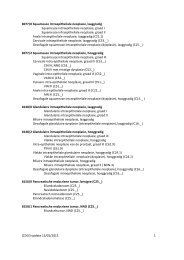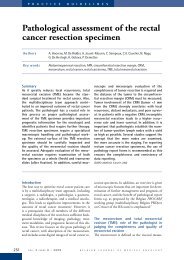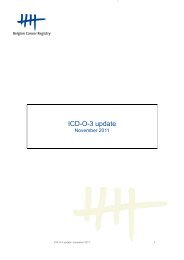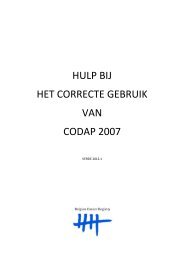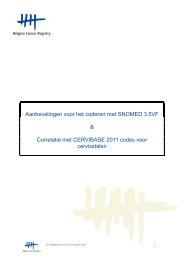Assurance de qualité pour le cancer rectal – phase 2 ...
Assurance de qualité pour le cancer rectal – phase 2 ...
Assurance de qualité pour le cancer rectal – phase 2 ...
Create successful ePaper yourself
Turn your PDF publications into a flip-book with our unique Google optimized e-Paper software.
72 PROCARE <strong>–</strong> <strong>phase</strong> 2 KCE reports 81As already mentioned above, a possib<strong>le</strong> threat for the PROCARE database is these<strong>le</strong>ctive inclusion of ‘good’ patients. Coupling with the administrative database to checkthe comp<strong>le</strong>teness of inclusion can be a solution.The advantage of administrative data is their efficiency. Since these data are alreadycol<strong>le</strong>cted for other reasons (e.g. epi<strong>de</strong>miology, financing, accreditation, etc.), the extraworkload for clinicians is negligib<strong>le</strong>. Above this, in contrast to the PROCARE database,the administrative database (which is population-based) inclu<strong>de</strong>s all Belgian patients with<strong>rectal</strong> <strong>cancer</strong>.However, administrative data lack specificity and <strong>de</strong>tail. In<strong>de</strong>ed, the se<strong>le</strong>cted QI in thisreport were often not measurab<strong>le</strong> using administrative data, because of the absence ofspecific administrative co<strong>de</strong>s or clinical data. Although the MCD database offers theadvantage to link procedures to diagnoses (in contrast to the HIC database), the linkageof the 3 different administrative databases did not have much impact on themeasurability of the QI.Administrative data are only availab<strong>le</strong> 2 to 3 years after registration. The quality of careis therefore measured with an important <strong>de</strong>lay. Above this, the request for theadministrative data and the coupling of the 3 databases turned out to be a longprocedure taking several months. Furthermore, many weeks were nee<strong>de</strong>d to gaininsight in the information availab<strong>le</strong> from this large database. Of course, the experiencefrom the present study can be used for future exercises.Importantly, since these administrative data are col<strong>le</strong>cted for (often financing) reasonsother than quality and are therefore associated with risks of up- or un<strong>de</strong>r-coding, theiruse for the measurement of the quality of care is at <strong>le</strong>ast questionab<strong>le</strong>.3.3.5 High versus low performance on quality indicatorsMost individual QI show enough variation to allow a distinction between centresoffering high vs. <strong>le</strong>ss quality care. This is essential and very re<strong>le</strong>vant, since it offerscentres the opportunity to act on specific procedures and outcomes.However, the QI set as a who<strong>le</strong> has <strong>le</strong>ss potential to distinguish overall high from lowperformance. Whi<strong>le</strong> the variation in mean corrected rank is acceptab<strong>le</strong> using thePROCARE database (with a high number of measurab<strong>le</strong> QI, but a low number ofcentres) (Figure 15), the variation in mean QI result is <strong>le</strong>ss pronounced (Figure 16). Onthe contrary, the variation in both mean corrected rank and mean QI result increasesusing the administrative database (with a low number of measurab<strong>le</strong> QI, but a highnumber of centres).It is difficult to give straightforward explanations for these results. One possib<strong>le</strong> reasonis that most PROCARE centres are performing on a similar overall quality <strong>le</strong>vel. This issupported by the analysis of the mean QI result using the administrative databases,where the PROCARE centres tend to be on the right si<strong>de</strong> of the graph (Figure 19), butrefuted by the analysis of the mean corrected rank using the administrative databases,where the PROCARE centres are represented on both si<strong>de</strong>s of the graph (Figure 17and Figure 18).Another possib<strong>le</strong> explanation is that this QI set is simply not balanced enough to allow adistinction between overall high and <strong>le</strong>ss quality care. Neverthe<strong>le</strong>ss, it is obvious thatmore centres and more patients per centre need to get involved in or<strong>de</strong>r to increasethe re<strong>le</strong>vance of these results. This would also allow risk-adjustment (e.g. ASA score forpostoperative mortality, tumour <strong>le</strong>vel for type of resection, tumour stage for (y)pCRM,etc.), which is essential for the distinction between high and low performance.No correlation was shown between the mean corrected ranks of 24 PROCARE centresusing the prospective and administrative databases respectively. This can have severalreasons. First, for some hospitals the data in the PROCARE database are notrepresentative for their entire <strong>rectal</strong> <strong>cancer</strong> population because of the se<strong>le</strong>ction bias(see above). Above this, a time lag exists between the 2 databases, ref<strong>le</strong>cting differentstandards of care. Finally, the mean corrected ranks are not calculated using the sameQI for both databases, and therefore may ref<strong>le</strong>ct other aspects of quality of care.



